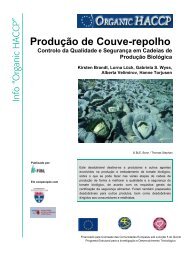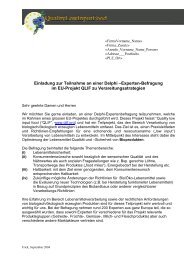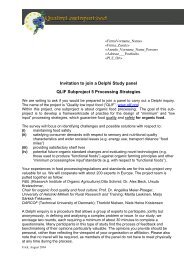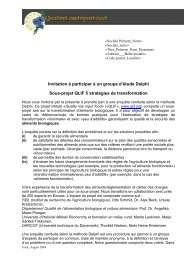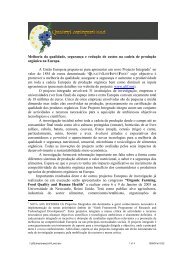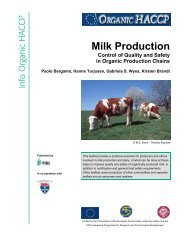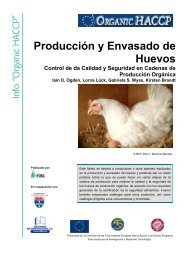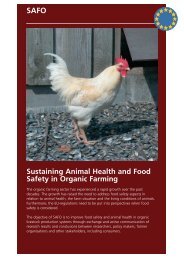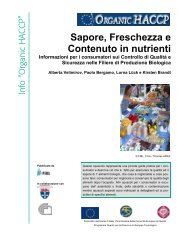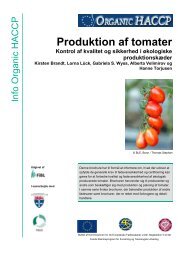Grape Production And Wine Processing
Grape Production And Wine Processing
Grape Production And Wine Processing
You also want an ePaper? Increase the reach of your titles
YUMPU automatically turns print PDFs into web optimized ePapers that Google loves.
Info Organic HACCP<br />
<strong>Grape</strong> production<br />
and <strong>Wine</strong> <strong>Processing</strong><br />
Control of Quality and Safety<br />
in Organic <strong>Production</strong> Chains<br />
Gabriela S. Wyss and Bo van Elzakker<br />
© FiBL, Frick / Jacques Fuchs<br />
Published by<br />
In co-operation with<br />
This leaflet provides a practical overview for producers and others<br />
involved in grape production and wine processing, of what can be<br />
done at these steps to improve the quality and safety of organically<br />
produced wine, in addition to certification and general food safety<br />
requirements. Other leaflets cover production of other commodities<br />
and separate leaflets aim at consumers and retailers.<br />
Funded by the Commission of the European Communities under Key Action 5 of the<br />
Fifth Framework Programme for Research and Technological Development
The Organic HACCP Project leaflets<br />
This is no.14 of a series of 14 leaflets comprising information<br />
on how control of quality and safety can be further improved<br />
in organic supply chains across Europe. The Organic<br />
HACCP project has reviewed studies of consumer<br />
concerns and preferences in relation to organic production<br />
systems and collected information about typical production<br />
chains for 7 commodities in regions across Europe. For<br />
each of the criteria listed below, the information was analysed<br />
to identify Critical Control Points (CCPs), defined as<br />
the steps in supply chains where the qualities of the final<br />
product can be controlled most efficiently. CCPs were identified<br />
using methods developed for Hazard Analysis by Critical<br />
Control Points (HACCP), a standard procedure to prevent<br />
food safety risks. The new aspect is thus to improve<br />
how consumer concerns are addressed, through the use of<br />
the CCP concept for a wide range of criteria, not only safety.<br />
1. Microbial toxins and abiotic contaminants<br />
2. Potential pathogens<br />
3. Natural plant toxicants<br />
4. Freshness and taste<br />
5. Nutrient content and food additives<br />
6. Fraud<br />
7. Social and ethical aspects<br />
Overview of the chains examined for wine making<br />
Chain R2<br />
(Italy)<br />
<strong>Production</strong> of<br />
grapes by single<br />
producer<br />
<strong>Wine</strong> making by<br />
producer<br />
Transport of wine<br />
by transport<br />
Bottling by wine<br />
processor<br />
Transport of<br />
bottled wine by<br />
mail order<br />
Retail by mail<br />
order company<br />
Chain R3<br />
(Portugal)<br />
<strong>Production</strong> of<br />
grapes by single<br />
producer<br />
<strong>Wine</strong> making by<br />
producer<br />
Bottling by wine<br />
producer<br />
Transport of<br />
bottled wine by<br />
health food store<br />
Retail by health<br />
food store<br />
Chain R4<br />
(Switzerland)<br />
<strong>Production</strong> of<br />
grapes by single<br />
producer<br />
Transport of<br />
grapes by<br />
producer<br />
<strong>Wine</strong> making by<br />
wine processor<br />
Bottling by wine<br />
processor<br />
Transport of<br />
bottled wine by<br />
producer<br />
Retail by<br />
producer<br />
Chain R5<br />
(Switzerland)<br />
<strong>Production</strong> of<br />
grapes by single<br />
producer<br />
Transport of<br />
grapes by<br />
producer<br />
<strong>Wine</strong> making by<br />
wine processor<br />
Botteling by wine<br />
processor<br />
Transport of<br />
bottled wine by<br />
producer<br />
Retail by<br />
producer<br />
Chain R6<br />
(Switzerland)<br />
<strong>Production</strong> of<br />
grapes by single<br />
producer<br />
<strong>Wine</strong> making by<br />
producer<br />
Botteling by<br />
producer<br />
Retail by<br />
producer<br />
The diagram shows the analysed organic supply chains for<br />
wine throughout Europe. On the project’s homepage<br />
(www.organichaccp.org) they are shown in more detail and<br />
each of the CCPs are shown and described.<br />
<strong>Grape</strong> production<br />
Important issues to control at this step<br />
The typical wine taste is mainly determined by the cultivar.<br />
Secondary metabolites are the source of wine flavour, colour<br />
and taste. Their content is dependent on the cultivar, the<br />
microclimate and the nutrient supply of the grape vine.<br />
<strong>Grape</strong>vines have a low nitrogen requirement. Over-use of<br />
N-containing organic fertiliser can have negative influence<br />
on taste-relevant components in the wine.<br />
Specific problems for organic production<br />
Spray drift in regions with small-scale grape production by<br />
less careful conventional farmers or by helicopter applications<br />
(data from FiBL studies; see chart below) may result in<br />
contaminated grapes. It is the organic farmer who needs to<br />
take action to prevent any contamination of its products.<br />
Conventional<br />
Organic Rows<br />
Spray Drift [%]<br />
100<br />
by helicopter<br />
by regular spraying<br />
50<br />
25 25<br />
5 5<br />
1 1<br />
The fungal disease downy mildew, Plasmopora viticola, has<br />
traditionally been controlled by the use of copper salts, also<br />
in organic farming. The use of copper-based pesticides is a<br />
problem for the image of organic farming among consumers,<br />
and many retailers demand copper-free production. It<br />
has been banned from both conventional and organic farming<br />
in some Scandinavian countries and the Netherlands.<br />
Recommendations<br />
Select cultivars with good taste and low susceptibility to<br />
downy mildew and other diseases and pests. Make sure<br />
they have been tested and performed well in your region.<br />
Limit the use of N containing fertiliser and harvest late<br />
after sunny, warm days to optimise wine taste.<br />
If pesticides can have drifted onto your vineyard, get a<br />
leaf sample analyzed. If residues are found, either i) ask<br />
your conventional neighbour to buy the affected grapes<br />
from you for the same price as organic and cost of the<br />
analysis, or ii) harvest the first two rows separately, with<br />
subsequent separate processing and marketing.<br />
Agree with neighbours and helicopter operations on<br />
safety measures such as spraying only under certain wind<br />
conditions with well-maintained equipment, using substances<br />
allowed in organic farming on part of the conventional<br />
vineyard, restricting where the nozzles are open.<br />
Establish hedges or other barriers to protect the crop from<br />
spray drift from neighbours, and promote merging of small<br />
areas with organic vineyards including exchange of land.<br />
Use less than the permitted amount of copper (or none)<br />
and prepare for copper-free production in the future. Develop<br />
replacement strategies including the use of clay<br />
minerals, plant tonic and resistant cultivars.<br />
2
<strong>Wine</strong> processing<br />
Specific problems for organic production<br />
In cellars with parallel processing of organic and non-<br />
with<br />
organic grapes, there is a high risk for contamination<br />
pesticides up to levels which are not in compliance with the<br />
consumers’ idea of organic wine: Either mixing up of organic<br />
and non-organic grapes or juice, or carry-over of residues<br />
from insufficient cleaned hoses, filter layers, containers as<br />
well as the press, the bottling machine and handling of small<br />
volume containers.<br />
Recommendations (parallel wine processing operations)<br />
Evaluate each step along the processing line to locate<br />
those steps where pesticide residues can be introduced.<br />
As far as possible use dedicated organic equipment,<br />
hoses, containers, filters etc. (paint in different colours).<br />
Even if not required by the certifier, always process or-<br />
ganic material before non-organic, and thoroughly clean<br />
the entire system before starting up again with organic.<br />
Especially the filter layers may accumulate pesticides.<br />
Maintain permanent identification of each batch.<br />
Monitor and document both organic and non-organic<br />
activities (input-output reconciliation).<br />
<strong>Wine</strong> storage<br />
Important issues to control at this step<br />
As a grape producer stay in close contact with your wine<br />
maker, and discuss the problems which may rise with<br />
parallel processing in the wine cellar. Also exchange information<br />
about your quality control and their quality<br />
measurements with the companies and persons in charge<br />
of the other parts of the chain. Formal collaboration<br />
agreements can ensure that quality and safety is controlled<br />
at every step of the supply chain, and that the<br />
costs of this are shared fairly among the participants.<br />
Establish and maintain your own quality assurance system<br />
to prevent contamination or mislabelling: For each<br />
step, describe how it should be done on a checklist. Imag-<br />
ine what can go wrong and decide in advance what to do<br />
in each case of theoretical problems and accidents that<br />
may occur. Fill in these checklists for each batch, with<br />
date and time for each procedure and with notes describ-<br />
ing anything unusual that happened.<br />
Provide permanent identification of batches. Take retain<br />
samples of wine from all batches and let them analyse if<br />
you are in doubt.<br />
Continuation in other EU or national projects<br />
The work of Organic HACCP identified several areas where<br />
more research is needed to improve the control of quality<br />
and safety of organic products.<br />
The following topics relevant for quality and safety of grape<br />
production and wine making will be investigated in further<br />
EU or national projects:<br />
Replacement of Copper Fungicides in Organic <strong>Production</strong><br />
of <strong>Grape</strong>vine and Apple in Europe (REPCO), 6th Framework<br />
Programme, Contract no. 501452, Running from<br />
11/2003, 36 Months. Webpage: http://www.rep-co.nl/.<br />
Within the “Bundesprogramm Ökologischer Landbau”<br />
several projects deal either with replacement strategies<br />
for copper or general copper reduction, with the (biological)<br />
control of important fungal diseases of vine (Peronospora<br />
spp. and Oidium spp.) or preventive plant protection<br />
strategies; see http://www.bundesprogrammoekolandbau.de/projektliste.html,<br />
keywords: Pflanze,<br />
Wein (in German).<br />
Recommendations<br />
Parallel storage of un-bottled organic wine with non-organic<br />
and/or in conversion material increases the risk for uninten-<br />
tional or intentional blending to improve quality or increase<br />
financial gain. Consumers are concerned about the risk of<br />
fraud, especially when organic wine is much more expensive<br />
than wine produced conventionally.<br />
Store the wine in dedicated organic tanks/cellars.<br />
Maintain permanent identification of each batch on the<br />
tanks and casks.<br />
Monitor and document both organic and non-organic<br />
activities (input-output reconciliation).<br />
When bottling, make sure the label contains the name<br />
and address of the producer and the batch number.<br />
General Recommendations<br />
3
Editorial Notes<br />
The editors and authors gratefully acknowledge financial<br />
support from the Commission of the European Communities<br />
under Key Action 5 of the Fifth Framework Research and<br />
Technological Development Programme and co-funding by<br />
the Swiss Science Agency (SBF) for the project "Recommendations<br />
for improved procedures for securing consumer<br />
oriented food safety and quality of certified organic products<br />
from plough to plate" (Organic HACCP; QLK1-CT-2002-<br />
02245). The views expressed are those of the authors and<br />
do not necessarily reflect the views of the European Commission,<br />
nor do they in any way anticipate the Commission's<br />
future policy in this area.<br />
The content of the leaflet is the sole responsibility of the<br />
authors. The information contained herein, including any<br />
expression of opinion and any projection or forecast, has<br />
been obtained from sources believed by the authors to be<br />
reliable but is not guaranteed as to accuracy or completeness.<br />
The information is supplied without obligation and on<br />
the understanding that any person who acts upon it or otherwise<br />
changes his/her position in reliance thereon does so<br />
entirely at his/her own risk.<br />
Bibliographical Information<br />
Gabriela S. Wyss, Bo van Elzakker (2005): <strong>Grape</strong> <strong>Production</strong><br />
and <strong>Wine</strong> <strong>Processing</strong>, Control of Quality and Safety in<br />
Organic <strong>Production</strong> Chains. Research Institute of Organic<br />
Agriculture FiBL, CH-5070 Frick, Switzerland<br />
© 2005, Research Institute of Organic Agriculture FiBL and<br />
University of Newcastle Upon Tyne<br />
FiBL, Ackerstrasse, CH-5070 Frick, Tel. +41 62 865 72<br />
72, Fax +41 62 8657 273, e-mail info.suisse@fibl.org,<br />
Internet http://www.fibl.org<br />
University of Newcastle, Agriculture Building, UK – NE1<br />
7RU, Newcastle upon Tyne, e-mail<br />
organic.haccp@ncl.ac.uk, Internet<br />
http://www.ncl.ac.uk/afrd/tcoa/<br />
Language editing: Kirsten Brandt<br />
Cover & layout: FiBL<br />
Logo Organic HACCP: Tina Hansen, DIAS, Denmark<br />
A PDF version can be downloaded free of charge from the<br />
project internet site at www.organichaccp.org or from<br />
www.orgprints.org/view/projects/eu-organic-haccp.html.<br />
Printed versions can be ordered from the FiBL Shop at<br />
www.shop.fibl.org.<br />
Authors<br />
Gabriela S. Wyss (FiBL) and Bo van Elzakker (Agro Eco).<br />
Contact:<br />
Dr. Gabriela S. Wyss FiBL: Ackerstrasse, Postfach, 5070<br />
Frick, Switzerland.<br />
Tel. +41 62 865 72 72<br />
Fax +41 62 685 72 73<br />
e-mail: gabriela.wyss@fibl.org<br />
http://www.fibl.net/fibl/team/wyss-gabriela.php<br />
About Organic HACCP<br />
The main objectives of this Concerted Action are to assess<br />
current procedures for production management and control<br />
in organic production chains, with particular reference to the<br />
characteristics valued by consumers, and from this to formulate<br />
and disseminate recommendations for improvements.<br />
The 2-year project started in February 2003. The results of<br />
the project, including a database of Critical Control Points in<br />
the analysed chains, are available on the project website<br />
www.organichaccp.org.<br />
The Project Partners<br />
University of Newcastle (UNEW), Newcastle upon Tyne,<br />
United Kingdom.<br />
Research Institute of Organic Agriculture (FiBL), Frick,<br />
Switzerland.<br />
Royal Veterinary and Agricultural University (KVL), Copenhagen,<br />
Denmark.<br />
Italian National Research Council, Institute of Food Science<br />
(CNR-ISA), Avellino, Italy.<br />
University of Aberdeen (UNIABDN), Aberdeen, United<br />
Kingdom.<br />
Ludwig Boltzmann Institute for Biological Agriculture (LBI)<br />
Vienna, Austria.<br />
Universidade de Trás-os-Montes e Alto Douro (UTAD),<br />
Vila Real, Portugal.<br />
Agro EcoConsultancy BV (Agro Eco), Bennekom, The<br />
Netherlands.<br />
National Institute for Consumer Research (SIFO), Oslo,<br />
Norway.<br />
4




